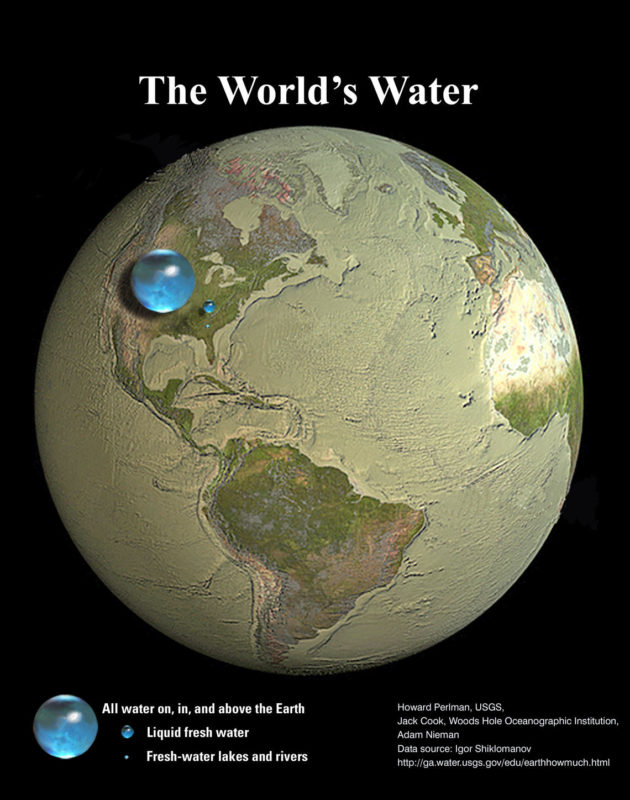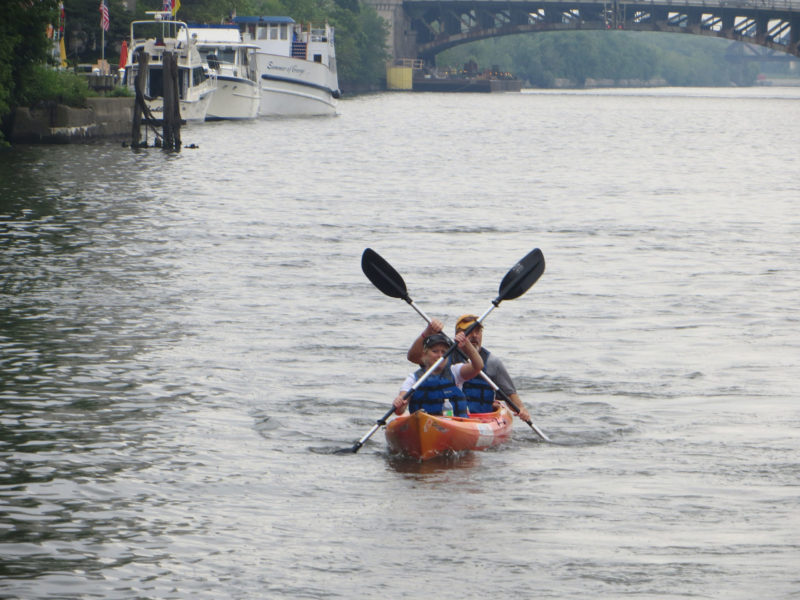By Robert Hirschfeld
This image of the earth, with all its water extracted and set beside it at scale, brings home just how limited and precious this life-giving resource is. The largest blue sphere represents all water on earth. The middle sphere represents all freshwater. And that tiny dot floating above Georgia represents all that water that exists on the earth in lakes and rivers. That’s it. All the fresh surface and groundwater that sustains life on earth. And yet, despite knowing full well that humans cannot survive more than a matter of days without clean water, we have been reckless with it. We have polluted it, poisoned it, mined it, and wasted it.

Aldo Leopold wrote, “Our tools are better than we are, and grow faster than we do. They suffice to crack the atom, to command the tides, but they do not suffice for the oldest task in human history, to live on a piece of land without spoiling it.”
Indeed, as far back as we can peer into the past, it’s evident that human settlements have often struggled to balance the extraction of value from the land and the thoughtful stewardship of it. But the explosive growth of industry throughout the 19th and 20th centuries provided a rapidly expanding population with the means to inflict new horrors onto our lands and waters, at a pace and scale never-before-seen. (Photo credit: Howard Perlman, USGS)
By 1969, the Cuyahoga River in Ohio was one of the most polluted rivers in the country. A stretch of 50 miles from Akron to Cleveland was entirely devoid of fish. In the preceding century, the Cuyahoga had caught fire at least a dozen times. But by 1969, something had changed. So when the Cuyahoga burst into flames again, this time due to petroleum products dumped directly into the river, the story of a burning, smoking river was met with shock and horror at its utter wrongness. A shift had occurred in Americans’ attitudes toward the environment.
The burning of the Cuyahoga, along with other prominent environmental maladies around the US, galvanized a nascent environmental movement and took it mainstream. Clean water was something that transcended boundaries and differences. A slew of new environmental measures followed. The US EPA was established in 1970. And in 1972, Congress, in a show of overwhelming bipartisan support for the environment, passed the Clean Water Act.
Richard Nixon’s EPA Administrator, William D. Ruckelshaus, urged him to sign the bill into law, telling the president, “It seems reasonable to me to spend less than one percent of the Federal budget and 0.2 percent of the Gross National Product over the next several years to assure for future generations the very survival of the Gross National Product.” Nevertheless, Nixon vetoed it. But Congress, again by wide margins, overrode the veto and the Clean Water Act became American law.
The Clean Water Act is a milestone in American history; it is one of the first modern environmental laws and its importance and influence are still felt today. In many respects, the Clean Water Act succeeded. The Clean Water Act targeted what’s known as point-source pollution – pollutants entering waters from the end of a pipe. And, indeed, the volume of pollutants entering waterways, particularly from factories and sewage treatment facilities, decreased significantly. The loss of wetlands (caused by filling them) was slowed. Many waterways are cleaner today than when the Act was passed.

The Chicago River, a great urban river, and once the dumping ground for an entire city’s waste, is a prime example of the success of the Clean Water Act. Not long ago the Chicago River was a toxic stew of sewage, industrial pollutants, and livestock yard waste. Today, fish and wildlife have returned. Paddlers are out on the water. And, if you keep your eyes open, you might spot river otters or beavers. All of this was unthinkable a few decades ago. (Photo credit: David Wilson, Flickr)
So there have been great successes. But one of the Act’s stated goals was that all US waters should be swimmable and fishable by 1983. Almost forty years later, and we are not even close to that goal. A report released in March 2022 found that half of America’s rivers and streams are impaired – neither swimmable nor fishable. As momentous as the Clean Water Act was, there are many pollutants that it does not regulate, particularly runoff from agricultural landscapes, something we’re very familiar with in the Midwest.
This year marks the 50th anniversary of the Clean Water Act. We should celebrate that and mark how far we’ve come. But part of that celebration must be a recognition that we have a long ways to go. Our tools may grow faster than we do. But the CWA was an indication that we too, can grow. We need to take another step forward. I’ll discuss where we go from here in the next newsletter.







